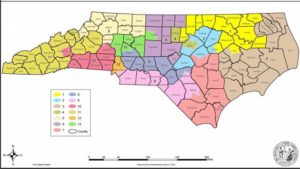North Carolina has a problem – a map problem to be specific.
Both North Carolina’s Generally Assembly map and the U.S. Congress map have been challenged in federal and state courts.
In an email, Dr. Todd Collins, WCU’s Public Policy Institute Director and political science professor, explains how the two maps impact North Carolina’s future elections and politics as a whole.

A map of the new congressional districts drawn during the Feb. 18 redistricting session. Image courtesy of wral.com.
On Tuesday, Feb. 6, the Supreme Court partially stopped the use of newly redrawing for state legislator maps as decided in North Carolina v. Covington. However, the lower federal court already had someone redraw several North Carolina districts because older ones were based too much on race. As a result, some of these redrawing will take effect.
However, the majority stayed the use of districts in Wake and Mecklenburg counties will remain the same. As a result, those counties will be using the old legislator maps while the rest of the state will be using new ones.
Since these new districts will be used in the upcoming election season, which starts Monday, Feb., 12, there are some uncertainties when it comes to candidates’ plans.
WCU’s Department Head of Political Science and Public Affairs, Dr. Christopher Cooper, provided an explanation.
“The new lines will likely increase Democratic seats in the General Assembly, and this difference might nudge the Democrats closer to breaking the super-majority,” said Cooper in a an email. “Even with this decision, however, it is unlikely (and close to impossible) that the Democrats could take over the majority in the General Assembly.”
However, this isn’t the case in Wake County since they will be using older maps that favor Republican candidates.
For example, two Wake County Democrats, Jenn Ferrell and Matt Calabria, were set to run against seven-term Republican House Representative Nelson Dollar. With the court’s decision, neither of the democrats live in Dollar’s district and are now unable to run against him.
While the General Assembly legislator maps saw some changes, North Carolina’s congressional maps most likely won’t be redrawn before this year’s upcoming elections.
As Collins explained, the Supreme Court decision on Jan. 18, put a hold on the requirement to redraw maps for the U.S. Congress. The decision coming from Rucho v. Common Cause. As a result, the current maps in place for the US Congress will still be used for upcoming 2018 elections.
While a lower court ruling would’ve required North Carolina to redraw district lines before upcoming elections due to the older districts being based too heavily on political parties, the Supreme Court issued a stay.
Collins thinks the Supreme Court issued the stay due to similar cases.
“The likely reason that the Supreme Court made this ruling is because it is currently hearing a very similar case out of Wisconsin about partisan gerrymandering,” said Collins in an email. “So it is not unusual for the Supreme Court to order a stay when it will rule on this exact issue very soon.”
Collins also explains that decisions made by the Supreme Court shows that there is a split among the justices.
“Both of these orders also don’t mean that the current districts are valid or constitutional, it just means that North Carolina does not have to adopt the new maps while the case is still pending on appeal,” said Collins. “The Supreme Court could later rule that all of these districts are unconstitutional.”
As a result of both maps, there are a lot of questions that still need to be answered.
First, whether the North Carolina legislature relied too much on political parties when drawing the maps. This could be decided by the pending Supreme Court case Gill v. Whitford that challenges Wisconsin’s district based on partisanship.
“If the Supreme Court strikes down partisan gerrymandering in the Gill case, it will make it much easier for the NC districts to be struck down based on partisanship,” said Collins.
However, for the issue of improperly using race when drawing the maps, the Supreme Court may revisit the issue and have another ruling on North Carolina.
Despite what decision the Supreme Court makes about the cases above, North Carolina will have to redraw all of its districts after the 2020 US Census. Until then, it’s a race between parties to control how the maps are drawn and Collins explains why.
“For Republicans, it is important to try and keep the current maps which give them an advantage,” said Collins. “For Democrats, there is an incentive to challenge the current maps in order to get maps that might be more favorable to them so that they can try to take over the state legislature before 2020.”
Related Story:


